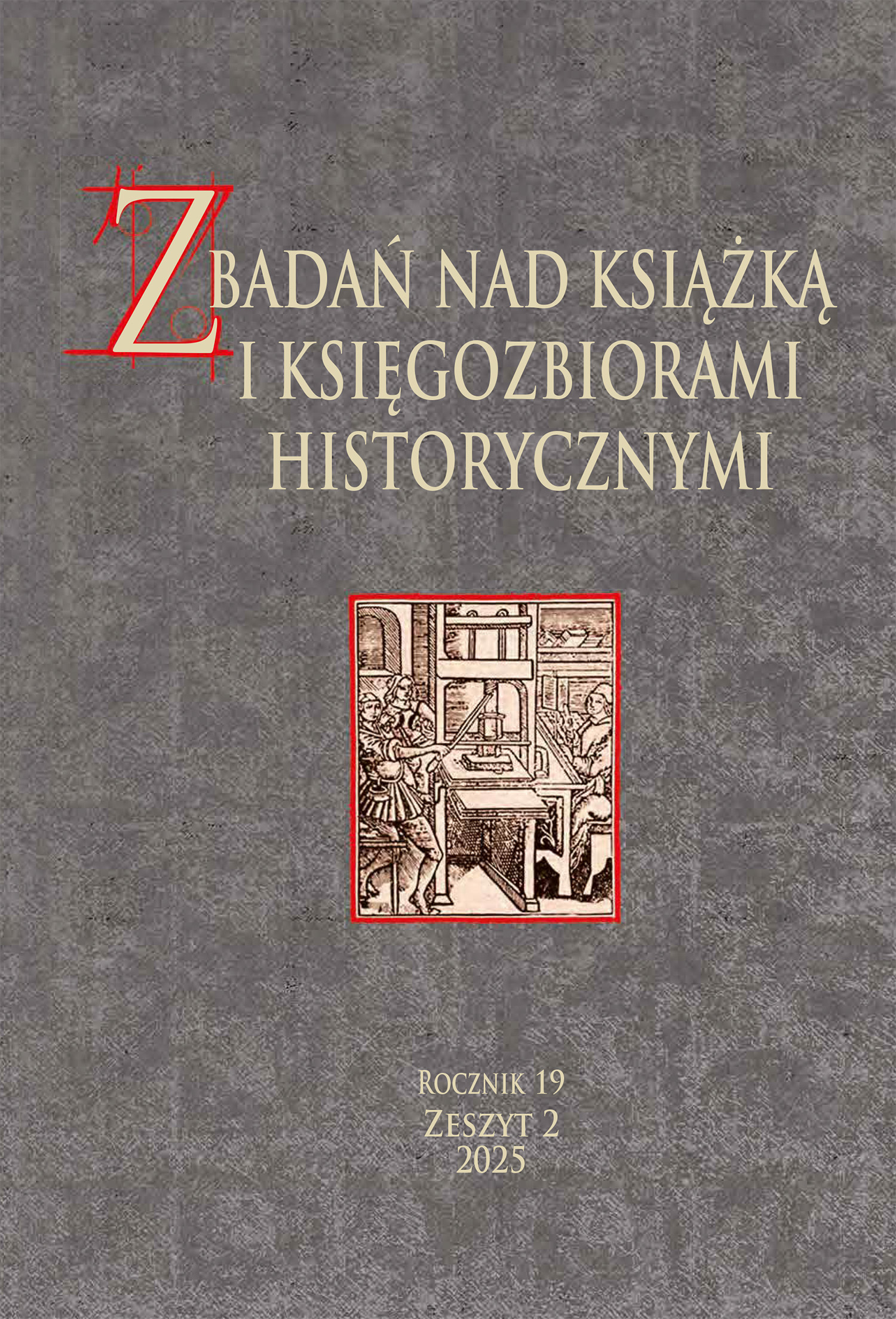Review of manuscripts
The „Studies into the History of the Book and Book Collections”uses double-blind reviewing. The subject editors responsible for original research papers and source materials peruse the manuscripts. The texts within the scope of the journal are then sent to two reviewers, who offer their opinion on an unified form.
Main areas of the review are:
- compatibility to the journal’s scope
- meritorious value of a text
- its logical arrangement and clear communication.
After receiving the reviews, the Editorial Board makes a final decision on accepting the manuscript, accepting it after revisions, or rejecting it. The whole process takes 6 to 10 weeks.
- compliance of the text with the journal's profile,
- fulfillment of formal requirements, i.e., compliance of the text with the guidelines provided in the instructions for Authors published on the journal's website,
- Articles that are unscientific or do not conform to the journal's profile are already rejected at this stage.
- are specialists in the field and are selected on the basis of the compatibility of their research profile with the subject matter of the submitted article,
- are not affiliated with the same unit as the Author of the article,
- in the case of texts in a foreign language, at least one of the reviewers is affiliated with a foreign institution other than the nationality of the Author,
- if the most competent specialist in a given field works at the same unit as the Author of the article, then such a person may be appointed as a reviewer of the article if he signs an undertaking that there is no conflict of interest between him and the Author of the article. Conflict of interest is considered to be direct personal relations (kinship, legal ties, conflict) between the reviewer and the author, relations of professional subordination, as well as direct scientific cooperation during the last two years preceding the preparation of the review.
- Reviewer’s statement
Review rules
- Reviewers participate in the works of the Editorial Team and have an influence on the decisions made by the Editorial Team. They can also, upon the consensus with the Authors, influence the final shape and polishing of the published works.
- The review is conducted in double-blind mode, which means that the Authors and Reviewers do not know each other’s identities.
- The surnames of the Reviewers of the respective issues are not published in a given number of the journal. Once a year the journal publishes the list of collaborating Reviewers.
- All scientific texts are reviewed (it does not apply to non-scientific reviews, reports, announcements, popular science articles, editorials).
- The Review takes place before the text publication after the text has been sent by the Author for the Editorial Team's evaluation.
- The Editorial Team ivites at least two independent Reviewers for evaluation of each publication from outside the scientific unit affiliated with the publication’s Author (external reviews). Texts in foreign languages are evaluated by at least one affiliated Reviewer from a foreign institution other than the Author of the work under review.
- The Editorial Team is responsible for the selection of the Reviewers, having in mind in particular research interests, scientific achievements and competencies of the Reviewer in the field of knowledge to which the text in question pertains.
- The Reviewer may refuse to conduct a review due to formal (e.g., conflict of interests, lack of possibility to meet the deadlines for carrying out a review) or informal reasons (scientific interests are not in line with the text’s subject matter). In such a case, the Reviewer is obliged to inform the Editorial Team of this fact immediately.
- It is unacceptable to invite the Editorial Team Member or Scientific Council Member as a Reviewer.
- The Editorial Team does not use reviews from other journals, commercial reviewing platforms, Internet forums etc.
- If the Editorial Team Member or the Scientific Council Member is the Author of a text, the selection of the Reviewer is the responsibility of another member of the Editorial Team other than the Author. The rules and obligations of the Author apply to such a person, whereas, the privileges for the Editorial Team Member or Scientific Council Member connected to participation in editorial work, reviewing process and making decisions about this text are not granted to such a person.
- The Review must be in the written form. The Reviewer may send a review form or complete the review using a suitable online form. The Review must contain an explicit evaluation regarding accepting the text for publication or its dismissal.
- Only texts which have undergone the review process and received two positive reviews can be accepted for publication by the Editorial Team.
- Texts which received one negative review in relation to which the Reviewer sees a possibility for accepting the text for publication after the text is corrected may be sent to the Author along with recommendations. The Author enters the adequate corrections, and then the text is sent for another review (the second round of review). Texts which have obtained one negative review may be dismissed by the Editorial Team without conducting the second round of review.
- Criteria taken into account during the review process are indicated in the reviewing form.
- The Editorial Team sends the Reviewer the reviewing form, which is the basic document in which the Reviewer may include her or his conclusions. The Reviewer may additionally attach other materials to the review form (e.g., written remarks, the text along with comments).
- The content of the Review is not publicised. Review reports may be made available to the Authors (after the anonymisation process.) Review reports are available to the Editors.
- Any interaction between Authors and Reviewers is unacceptable. Their contact is anonymised. Conclusions and review reports as well as Author’s replies are sent via the Editorial Team or using the right system allowing for data anonymisation in the double-blind review mode.
Rules for Preserving Objectivity Standards: Reviews should be objective. Personal criticism of Authors’ works is considered inappropriate. All observations of a Reviewer should be justified adequately.
Scholarly Integrity Rule: The Reviewers are committed to meeting the highest standards and ethics rules regarding the publication of scientific text and preventing practices that counteract the established standards. In order to do that they may enter adequate corrections, and also, in the case of suspicion of dishonest practices (plagiarism, falsifying research results etc.) or unethical actions, take a decision not to publish the text.
Fair Play Rule: Issues such as race, gender, faith, origin, nationality or political beliefs of the Authors must not, in any way, affect the result of the review Texts sent for publication are evaluated first and foremost in terms of their factual knowledge as well as formal and technical components. Decisions of the Reviewers must be based upon scientific values.
In the case of the Reviewer a conflict of interest may arise in circumstances where there are any doubts regarding her or his impartiality or her or his actions may be in any way influenced during the reviewing process, e.g., business, financial, legal affiliations; Reviewer’s opinions, scientific competition, and family relations.
In cases which have not been described in these Rules of Publication Ethics, the Editorial Team abides by the guidelines outlined in COPE Retraction Guidelines and COPE Flowcharts.





